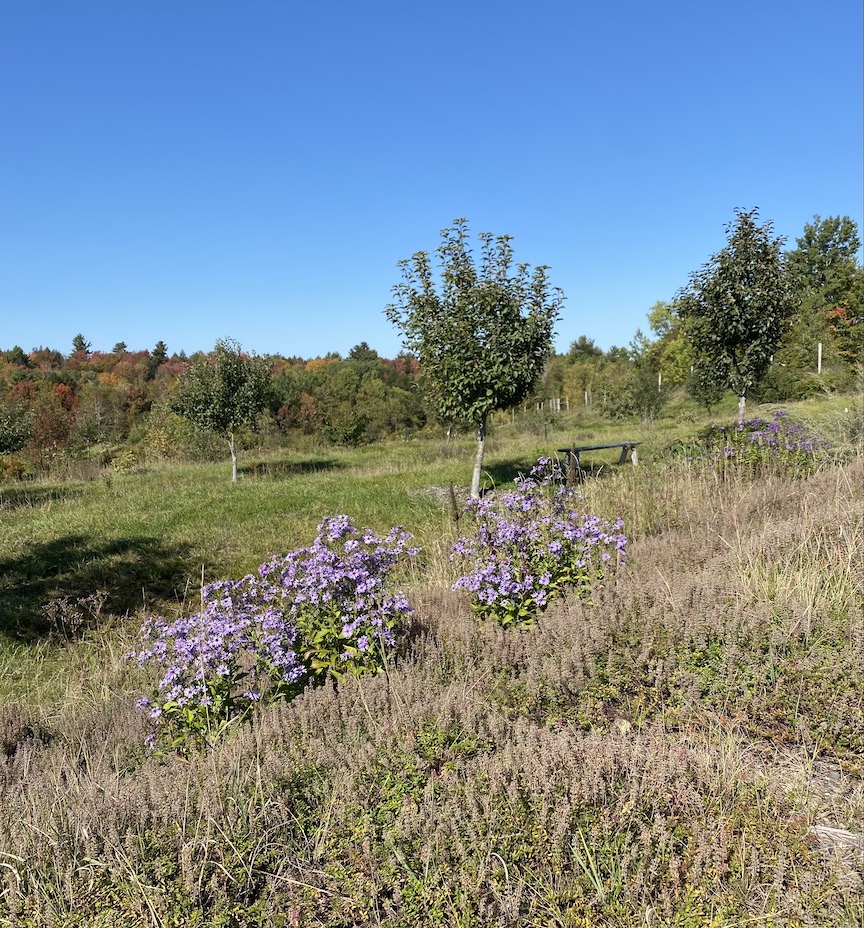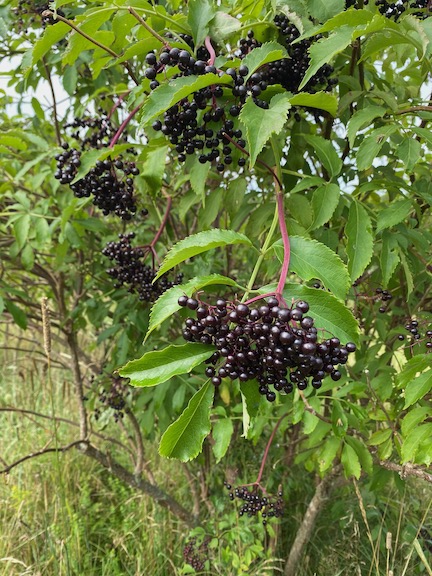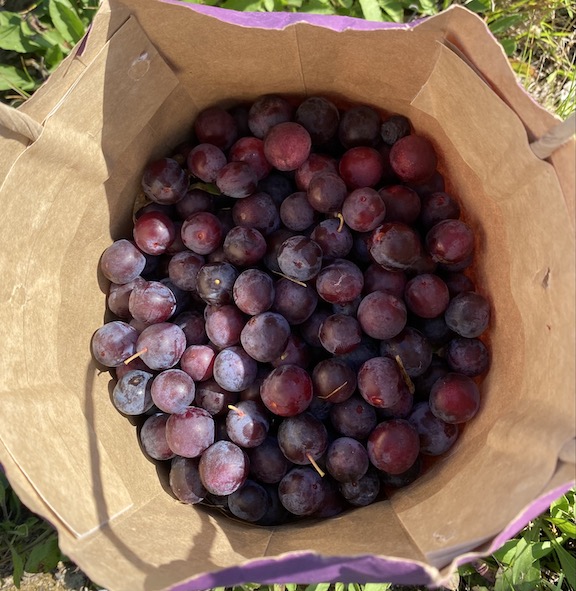By Jacob Mentlik
There is a lot more than just apples growing at the Maine Heritage Orchard. While most commercial orchards lean toward monoculture, featuring long even rows of one particular species of fruit tree, the goal at MHO is to create a polyculture orchard, with many species growing together in harmony, mimicking the diversity of a natural ecosystem. The conventional orchard design with standardized row spacing of fruit trees and minimal competition from other species is certainly valuable for growing large amounts of fruit. Long rows of a single variety with neatly mowed paths make the labor of pruning, harvesting and spraying more efficient and profitable. But there is an inherent lack of biodiversity in this model. At MHO all of the fruit trees are unique, and they are surrounded by a growing and varied community of clovers, grasses, flowers and shrubs.

This is not to say that the Maine Heritage Orchard is a jungle of plants growing wild. The site has been designed with the ongoing work of an orchard in mind. The apples and pears are all spaced 25 to 30 feet apart, and the rows and terraces are kept mowed, reducing the competition from weeds and grasses around the youngest trees. But rather than focusing on productivity and profitability, MHO is focused on the preservation of rare and unique varieties, as well as innovative orcharding practices. The idea is that a dynamic polyculture of many types of plants will help to nurture the focal fruit trees by attracting beneficial insects, accumulating nutrients in the soil and creating a rich environment where the orchard can thrive into the future. Each year more plants are added to the hillsides between the terraces and along the edges of the slopes, while the previous years’ plantings are beginning to take hold and naturalize.

You may not know it from looking at it now, but the site of the Maine Heritage Orchard was previously home to an active gravel pit. When MOFGA staff and volunteers first started working on the depleted property in 2013, it was a barren moonscape of dirt and rocks. Now, less than a decade later MHO is a lush, green, terraced hillside with a diversity of plant life. Various species of herbs, grasses and wildflowers fill the spaces between fruit trees, such as creeping thyme, blue vervain and clumping orchard grasses. Willows, bamboos and sweetferns have been planted on the steepest parts of the slope, where their roots will help to stabilize the soil, reducing runoff into a pond, which is being lined with water-loving plants such as buttonbush and red osier dogwood. Fruiting shrubs like aronia (black chokeberry), elderberry and various viburnums are planted along the edges of the orchard, providing a windbreak and habitat for beneficial insects and birds. Cranberries and cattails have been established in wet areas at the foot of terraces. As in a natural ecosystem, a diverse array of plants is beginning to inhabit the different spaces in the landscape that they are suited to.
The driving force behind all of these plantings is the desire to provide an ongoing source of food for our native pollinators. As we know, without pollinators there would be no fruit on our trees. Large orchards often rely upon commercial hives of honeybees and bumblebees, which are typically trucked in to do the job of pollination during bloom time and then moved to other large farms in need of pollinators for a short season. At MHO we try to encourage the presence of local bees and other pollinators throughout the year — not just when the apple blossoms are open. By planting a diverse range of flowers and flowering shrubs with staggered bloom times, we aim to support local pollinators throughout the seasons. Early spring bulbs and flowers such as narcissus, squill, anemone and colt’s foot provide some of the first food for pollinators before the fruit trees and various shrubs begin to bloom. Later in the season, several varieties of goldenrods and bright purple New England asters open up as the bulk of summer’s flowers begin to dwindle.

As a result of all of these plantings, MHO is now yielding its first significant sets of fruit. While apple trees on standard rootstocks can take up to 10 years to produce, many of the fruiting shrubs in the orchard have already begun to bear heavy crops. This abundant fruit is a huge source of nourishment for our local birds and other wildlife. Elderberries are devoured as they come ripe in mid-summer by birds such as grosbeaks and thrushes and rodents like red squirrels and white-footed mice. In turn, our resident fox hunts the mice so the rodents don’t girdle our trees. Aronia and viburnum berries can persist into the winter months, providing a much needed source of food for overwintering birds such chickadees and waxwings. These fruits have medicinal and culinary uses for us humans as well, and the orchard is a great place to collect berries — if we can get to them before the birds do!
In addition to feeding wildlife, these fruiting shrubs have become a repository of material for the propagation of more plants. The Maine Heritage Orchard and Fedco Trees have a long-lasting partnership, collaborating on many events and projects. MHO and Fedco share the goal of preserving and promoting rare and endangered fruit varieties, researching innovative orchard practices and getting more native and beneficial plants out into our landscapes. The bulk of the woody plants and perennials at MHO were supplied by Fedco Trees. Now these plantings are coming full circle, providing seed for the propagation of future woodies. This summer thousands of seeds were collected from the elderberry and aronia bushes that are thriving on the southern slope of the orchard. Beach plums, another native fruiting shrub, had their first large crop this summer. They were also collected and processed for seed.
The Maine Heritage Orchard is bursting with life. What was once a desolate pit mined for its deposits of sand and gravel is now a thriving and diverse community of trees, shrubs, grasses and flowers providing food and nourishment for insects, wildlife and humans alike. We encourage you to come tour the orchard and see for yourself.
Learn more about the Maine Heritage Orchard, including workshops and volunteer days held at the orchard, at mofga.org.
Jacob Mentlik is a nurseryman, orchardist and homesteader living at After the Fall Farm in Montville, Maine. He is also the scionwood coordinator for Fedco Trees and helps research and care for the trees at the Maine Heritage Orchard.
